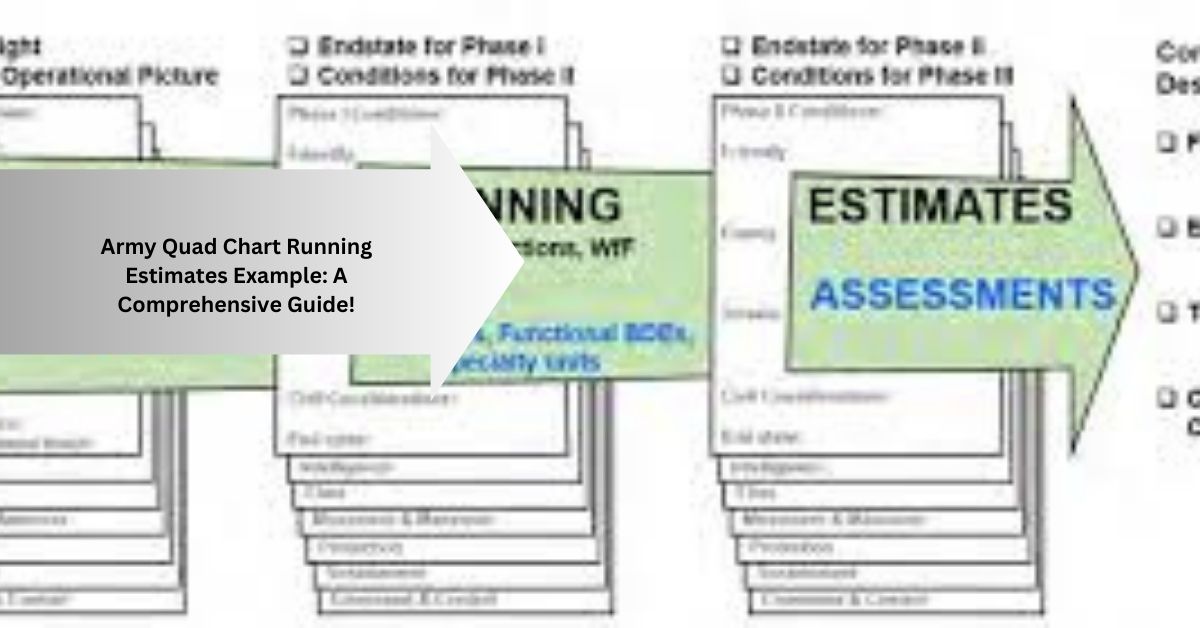Army Quad Chart Running Estimates Example: A Comprehensive Guide!
In the military planning process, the army quad chart running estimates example plays a pivotal role in providing an organized and continuous assessment of the situation. This chart is an essential tool for staff officers, allowing them to compile facts, assumptions, and constraints and support decision-making in dynamic operational environments like Large-Scale Combat Operations (LSCO). Understanding how to use and create running estimates, particularly within the quad chart format, is essential for any staff officer engaged in military planning.
What is an Army Quad Chart?
An Army Quad Chart is a visualization tool used to summarize information in four distinct quadrants. These quadrants typically cover:
- Facts – Current and verifiable data that impact planning.
- Assumptions – Unverified information or beliefs necessary to plan for contingencies.
- Constraints – Limits or restrictions that must be accounted for.
- Conclusions – Analytical insights derived from facts and assumptions that inform action plans.
The army quad chart running estimates example effectively organizes information into these quadrants, allowing leaders to make faster and more informed decisions.
The Role of Running Estimates in Military Planning
Running estimates are continuous assessments of the current situation, updated throughout an operation. These estimates evolve based on new information, changes in the environment, and the actions of both friendly and enemy forces. The army quad chart running estimates example offers a structured way to present these updates to commanders and staff during briefings and meetings.
Running estimates are crucial for maintaining situational awareness and are used by various staff sections, including intelligence (S2), operations (S3), and logistics (S4). The estimates allow staff to:
- Monitor progress.
- Identify risks and opportunities.
- Support decision-making with real-time data.
Components of a Running Estimate in an Army Quad Chart
- Facts In the army quad chart running estimates example, the facts section lists objective data such as enemy strength, weather conditions, and available resources. Facts are gathered through intelligence reports, surveillance, and direct observation.
- Assumptions Assumptions are informed predictions used when facts are unavailable. For instance, if intelligence reports are incomplete, assumptions are made about the enemy’s intentions or capabilities based on historical data or known strategies.
- Constraints Constraints are restrictions imposed by higher command or the operational environment. They may include rules of engagement, available time, or logistical limitations. In the army quad chart running estimates example, constraints must be clearly defined to guide the staff’s recommendations.
- Conclusions This is where all the gathered information is synthesized into actionable recommendations. The conclusions drawn in a running estimate are critical for proposing feasible courses of action (COAs) to the commander.
Example of an Army Quad Chart Running Estimate
Here’s a simplified army quad chart running estimates example:
| Quadrant | Description |
| Facts | Enemy forces in the AO number approximately 300. Weather will impact mobility. |
| Assumptions | The enemy will reinforce within 48 hours. Logistics supply lines are secure. |
| Constraints | Limited air support available due to poor visibility. Rules of engagement restrict civilian areas. |
| Conclusions | Recommend shifting maneuver elements to the west to avoid compromised terrain. |
This example demonstrates how the quad chart format distills complex operational information into an easily digestible summary, aiding in strategic and tactical decision-making.
Benefits of Using Army Quad Chart Running Estimates
The army quad chart running estimates example format offers several key advantages:
- Clarity: The quad chart format provides a concise and structured way to present complex information.
- Speed: By compartmentalizing data into quadrants, staff officers can quickly update and present relevant information to commanders.
- Consistency: Standardized formats ensure that running estimates from various staff sections are easy to interpret and compare.
In LSCO or other fast-moving environments, maintaining accurate and timely running estimates through the army quad chart running estimates example is vital for keeping commanders informed and ensuring operational success.
Importance of Continuous Updating in Running Estimates
One of the most critical aspects of the army quad chart running estimates example is its requirement for continuous updates. Unlike a static plan, a running estimate must evolve as new information becomes available or conditions change. This dynamic nature ensures that commanders are always receiving the most current and relevant data. The need for real-time updates is particularly crucial in operations where time is limited, and decisions need to be made quickly. Regularly updating the running estimate allows the staff to track changes in enemy movement, logistical challenges, or weather conditions, helping the commander adjust strategies effectively.
The continuous nature of running estimates also highlights the importance of communication between different staff sections. Each section, whether focused on intelligence, operations, or logistics, must contribute to the running estimate by sharing real-time information. This interconnectedness between staff sections ensures that decisions are made based on a holistic understanding of the battlefield.
Enhancing Decision Support with Army Quad Charts
The army quad chart running estimates example format significantly enhances decision-making processes by providing decision-makers with a visually organized tool that helps streamline complex data. Commanders face multiple variables when making decisions, and having information broken down into quadrants allows them to quickly absorb and evaluate critical data. The visual format eliminates the need to sift through lengthy documents or reports, presenting data in a way that highlights the most important elements: facts, assumptions, constraints, and conclusions.
Moreover, the structured approach ensures that all relevant factors are considered before making decisions. By forcing the staff to document facts and assumptions, the quad chart encourages careful consideration of available intelligence and potential risks. This method reduces the likelihood of overlooking key details that could negatively affect mission outcomes. The army quad chart running estimates example also helps identify knowledge gaps, enabling commanders to request additional intelligence or clarification before proceeding with a course of action.
Adapting Quad Charts to Different Operational Contexts
Another important aspect of the army quad chart running estimates example is its adaptability to different military contexts. Whether the operation is focused on intelligence gathering, logistics, or combat, the quad chart can be tailored to fit the specific needs of the mission. In intelligence operations, for example, the running estimate may focus more heavily on threat analysis and enemy capabilities, while a logistics-focused operation may prioritize constraints related to supply lines and transportation.
The flexibility of the quad chart makes it an essential tool in diverse military scenarios, from large-scale combat operations (LSCO) to humanitarian missions. Each staff section can modify the chart to suit their unique operational requirements, ensuring that relevant information is captured and presented in a standardized format. This adaptability not only improves communication within the command structure but also makes the chart an indispensable part of both strategic and tactical planning processes.
Training and Implementation of Running Estimates in the Army
Proper implementation of the army quad chart running estimates example requires thorough training for staff officers. Understanding how to effectively gather, analyze, and present data within the quad chart format is critical to ensuring its utility in decision-making. Army officers must be trained to recognize the importance of continuously updating their estimates and integrating input from multiple sources. Regular training exercises and simulations that include the use of running estimates and quad charts prepare staff officers for real-world scenarios where quick and accurate assessments are necessary.
Moreover, the implementation of the quad chart running estimate needs to be standardized across units to ensure consistency in how information is presented and interpreted. When units follow the same format, it becomes easier for commanders to quickly understand the data, regardless of which staff section has provided the update. This standardization improves the overall efficiency of the decision-making process, allowing military operations to proceed with greater cohesion and precision.
Conclusion
The army quad chart running estimates example is a powerful tool in military planning, enabling staff officers to provide a continuous, organized assessment of the situation. By structuring information into four key areas—facts, assumptions, constraints, and conclusions—the quad chart supports timely and informed decision-making. Whether in a briefing or during planning, the running estimate within a quad chart format remains a staple of military operations, particularly in LSCO scenarios. For those involved in military planning, mastering the use of this format is crucial for mission success.







